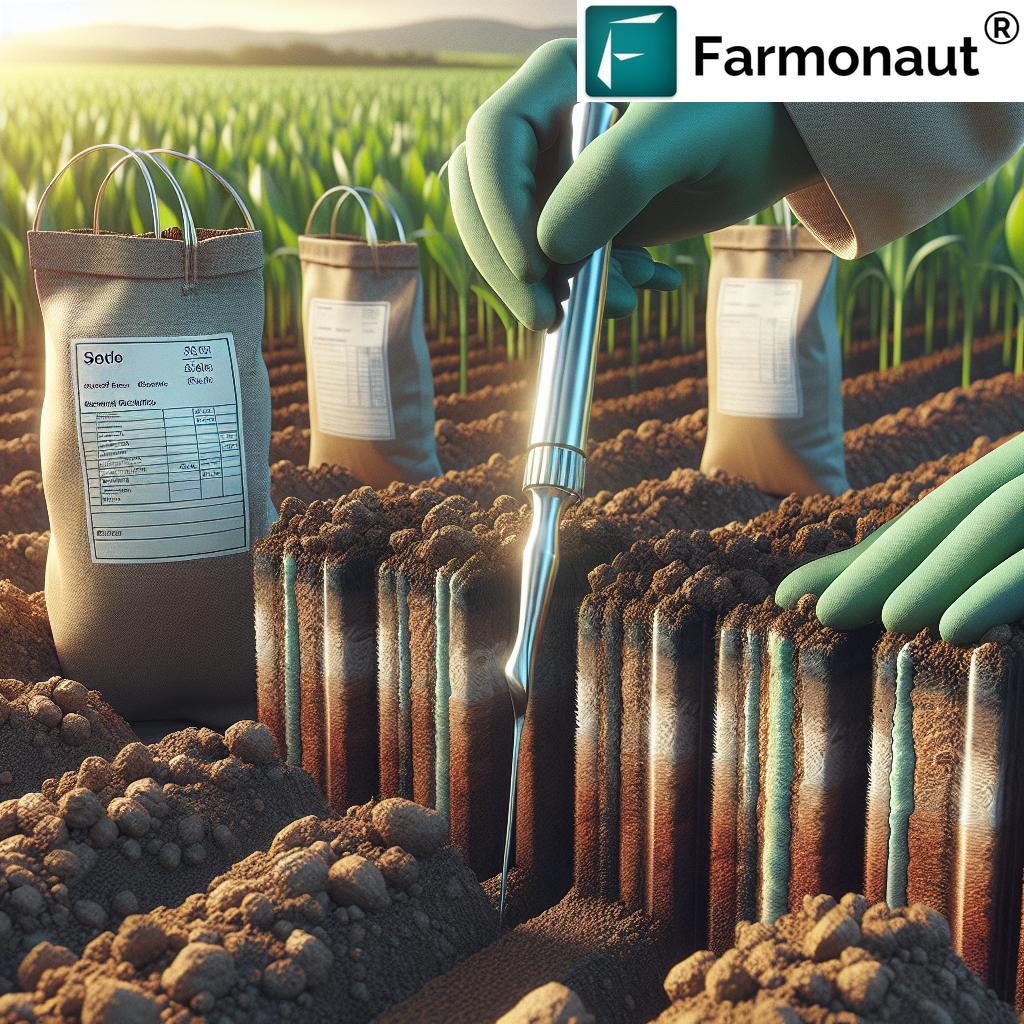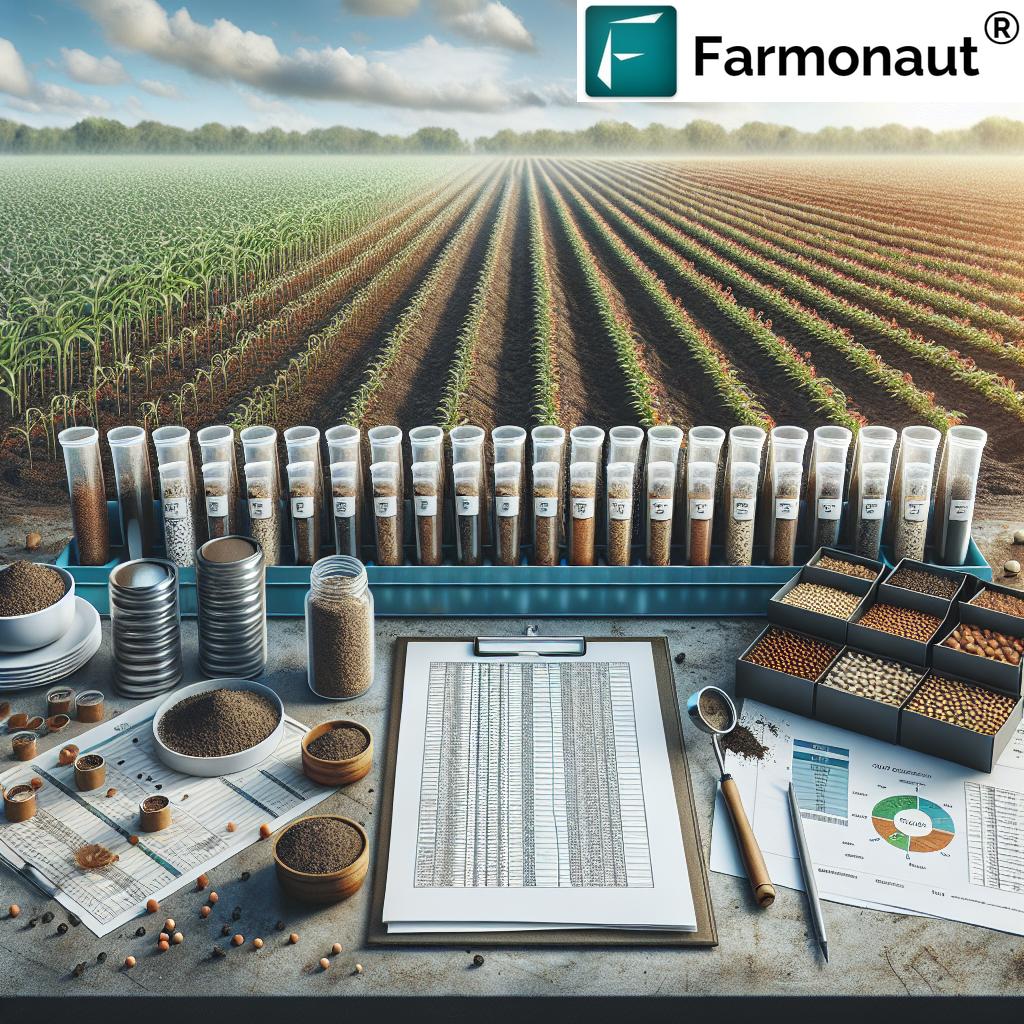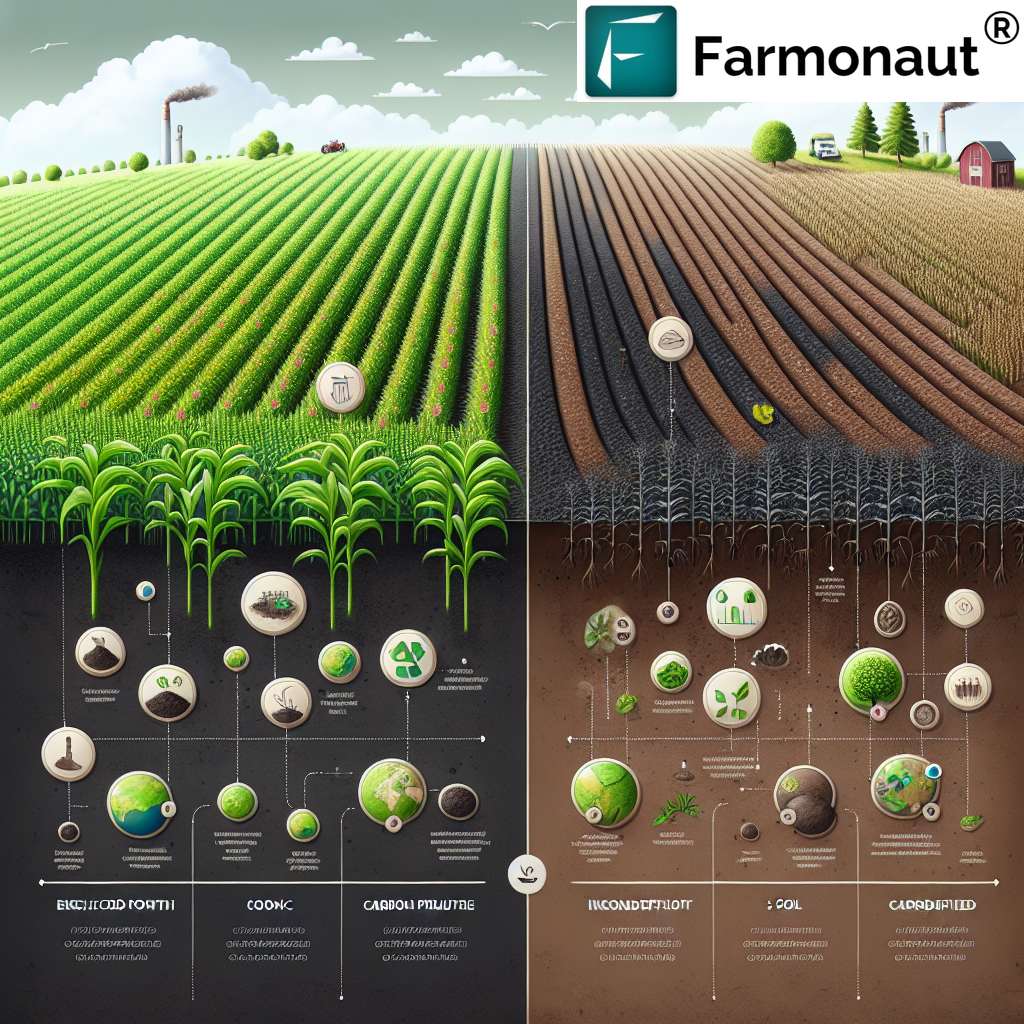Soil Sampling Secrets: Boost Yields with These 7 Tips!
“Proper soil sampling can increase crop yields by up to 20% through precise nutrient management.”
Table of Contents
- Introduction: Soil Sampling for Sustainable Agriculture
- The Importance of Soil Sampling
- When and How Often Should We Sample?
- Soil Sampling Secrets: 7 Top Tips for Boosting Yields
- Soil Sampling Methods & Estimated Yield Impact Table
- How to Interpret Soil Test Results for Effective Decision-Making
- Best Practices for Soil Sampling
- Farmonaut: Powering Precision in Soil Management
- Frequently Asked Questions About Soil Sampling
- Conclusion: Grow Sustainably with Smart Soil Sampling
Introduction: Soil Sampling for Sustainable Agriculture
As modern agricultural land managers and stewards, we understand that healthy, fertile soil is the lifeblood of every thriving farm, agricultural enterprise, and forestry plot. Soil sampling, a fundamental agronomy practice, provides us with a window into our land’s unique properties and nutrient status. Through consistent and accurate soil sample collection and analysis, we can unlock actionable data, enabling precise crop nutrient management and highly effective, environmentally sustainable decisions.
In this comprehensive guide, we’ll dive deep into the importance of soil testing, share seven proven tips for how to collect soil samples and achieve reliable results, examine leading sampling methods, and explore how innovative tools like Farmonaut’s satellite-powered technology enhance agricultural soil management. Whether you’re farming, managing forests, or practicing agroforestry, this blog will help you harness the power of soil sampling to boost your yields and sustainability.
The Importance of Soil Sampling in Crop and Forest Management
Soil sampling sits at the core of sustainable land management, agriculture, and forestry. But why is it so essential?
- Understanding Nutrient Levels: Soil samples reveal what nutrients are present, what’s lacking, and in what proportions. This empowers us to optimize soil amendments with surgical accuracy, meeting specific crop needs and reducing resource waste.
- Ensuring Environmental Sustainability in Farming: Precision in fertilization and liming not only maximizes yields—it minimizes runoff, reduces costs, and prevents pollution, safeguarding precious ecosystems.
- Promoting Soil Fertility and Health: Accurate, regular soil testing provides a vital snapshot of soil fertility and pH, so we can tailor our management practices for improved productivity and sustainability.
- Facilitating Long-Term Planning: By systematically monitoring soil changes year after year, we gain insights into long-term effects of our crop rotation, previous fertilization, and land management strategies.
Through strategic soil sampling, we simply make better decisions—enhancing crop health, yield, and resilience while advancing our sustainability mission at every turn.
Benefits of Soil Sampling
- Targeted Application: Enables precise fertilizer use and reduces over-application.
- Cost Savings: Optimizes input costs by applying only what’s needed, where it’s needed.
- Yield Maximization: Aids crop yield improvement through soil testing by ensuring plants never fall short on nutrients or hit toxic thresholds.
- Environmental Protection: Reduces soil and water contamination and helps preserve biodiversity.
- Regulatory Compliance: Helps us adhere to regional or national regulations for nutrient management and environmental sustainability in farming.
With regular, well-executed soil sampling, every farm—large or small—can thrive more profitably and responsibly.
“Over 60% of farmers see improved soil health after adopting sustainable sampling and nutrient practices.”
When and How Often Should We Sample?
For accurate and actionable results in soil fertility analysis, two questions are crucial: When is the optimal time to collect samples? And how often should we sample our fields?
1. When to Sample
- Fall (Post-Harvest): Soil samples taken after harvest reveal the residual effects of the growing season and support the adjustment of winter or spring amendments.
- Spring (Before Planting): Sampling before planting provides current data for developing nutrient management plans ahead of the growing season.
- Consistency is Key: Always sample fields at the same time of year for reliable tracking of soil changes and trend analysis.
2. How Often to Sample
- Standard Recommendation: Every two to four years is sufficient for most fields in regular agricultural rotation.
- High Variability/Changing Management: Farms with highly variable soils or significant management changes (new crops, altered rotations, or major amendments) may require more frequent sampling—sometimes annually for best results.
- Continuous Monitoring: For precision agriculture and optimized nutrient use, annual or biannual sampling is a best practice, especially in high-value crops.
Important Factors Influencing Sampling Timing and Frequency
- Soil Type: Sandy soils change faster; clay soils may retain nutrients longer.
- Crop Rotation & Management History: Previous fertilization, liming, crop choices, and organic matter inputs all affect nutrient levels and soil properties.
- Field Variability: Fields with visible variability, unusual patches, or known issues should be sampled in smaller, more targeted zones for precise results.
- Environmental Conditions: Avoid sampling in extreme wet or dry conditions for best reliability.
By understanding when and how often to sample, we strengthen the foundation for crop yield improvement through soil testing and build our farm’s resilience.
Soil Sampling Secrets: 7 Top Tips for Boosting Yields
Soil sampling isn’t just an annual task—it’s a strategic process involving sound planning, clean equipment, standardized techniques, and thorough records. Let’s explore the seven key secrets to reliable, effective, and sustainable soil sampling.
Tip 1: Choose the Right Sampling Areas
- Uniformity Matters: Always select sampling areas with uniform crop, soil type, color, texture, and past management. This ensures the results represent the area’s true nutrient status.
- Avoid Anomalies: Stay away from visible problem spots (e.g., manure piles, fence lines, old building sites, eroded patches) to prevent sample contamination and misleading results.
- Mark & Map: Use GPS or digital mapping (like Farmonaut’s monitoring platform) to record sampling locations for future consistency.
Tip 2: Use Clean and Appropriate Sampling Tools
- Tools: Stainless steel or chrome-plated augers, tubes, or trowels are best—they prevent chemical contamination. Avoid galvanized, brass, or bronze tools to keep heavy metals out of your samples.
- Cleaning: Wash and dry equipment thoroughly between fields and samples. Always use clean containers to avoid cross-contamination.
- Tech Integration: Consider digital soil mapping equipment or Farmonaut’s satellite-based field management solutions to streamline your process.
Tip 3: Sample at the Correct Depth
- Annual Crops (fields, grains, vegetables): Collect soil from the top 6 to 8 inches (15-20 cm), corresponding to typical tillage depth.
- Perennial Crops, Pastures & No-Till Fields: The top 4 inches (10 cm) is usually sufficient—root zones and surface conditions drive most nutrient dynamics here.
- Consistency: Always sample to the same depth each year for accurate tracking of soil changes and nutrient levels.
Tip 4: Collect Multiple Subsamples for Each Field
- Composite Sampling: Take a minimum of 10 to 15 evenly spaced cores in each defined sampling area. This guards against random anomalies and creates a truly representative sample.
- Larger or Highly Variable Fields: Increase the number of subsamples, or divide the field into smaller sampling zones for improved accuracy.
- Mixing: Combine all subsamples in a clean container and stir thoroughly before submitting a portion for analysis.
Tip 5: Timely Handling and Proper Storage
- Air Dry: If samples can’t be delivered to a lab immediately, air dry them within 12 hours. This prevents microbial changes that can alter nutrient results.
- Container: Use clean plastic bags or sample boxes—never metal or dirty bags—to maintain sample integrity.
- Label Clearly: Mark all samples with field name, area, date, and sample depth for traceability and organization.
Tip 6: Accurately Record and Track Each Sample
- Use Mapping Tools: Digital farm management apps and mapping software (e.g., Farmonaut’s mobile or web applications) help us log GPS locations, sample times, depths, and previous field conditions for repeatability.
- Consistent Naming: Develop a simple naming system for your fields and sub-areas to streamline organization across years.
- History: Keep detailed notes of previous fertilization, liming, and crop rotations for more insightful data interpretation.
For large-scale or multi-field operations, Farmonaut’s Large Scale Farm Management solution is ideal. It helps automate field mapping, sample tracking, and analysis across hundreds or even thousands of hectares, making life easier for organizations and cooperatives.
Tip 7: Submit to a Certified Soil Testing Laboratory
- Certified Labs: Choose a laboratory that meets regional standards for soil nutrient management, with expertise in local crops and conditions.
- Custom Recommendations: Quality labs not only test your samples, but also interpret results and recommend fertilizer and lime applications tailored to your needs.
- Digital Results: Some labs integrate with digital platforms—like Farmonaut—enabling you to access and analyze soil data on your phone or computer for timely, data-driven fertility management decisions.
Ready to embrace the future of traceable, digital farm records? With blockchain-based product traceability from Farmonaut, you can ensure every step—from soil sampling to market—is transparent, auditable, and trusted by buyers and regulators alike.
Soil Sampling Methods & Estimated Yield Impact Table
Not all sampling strategies are created equal! Here’s a straightforward comparison of the most common soil sampling methods, their impact on yield, nutrient efficiency, and environmental sustainability.
| Sampling Method | Estimated Yield Boost (%) | Nutrient Efficiency Improvement (%) | Environmental Impact |
|---|---|---|---|
| Grid Sampling | 10–20% | 20–30% | Reduces nutrient runoff, supports tailored fertilizer use |
| Zone Sampling | 12–18% | 18–28% | Improves soil health, minimizes over-application |
| Random Sampling | 7–12% | 10–15% | Basic improvement, mid-level environmental benefit |
| Management Zone Sampling (using satellite imagery/local digital mapping) |
15–22% | 25–35% | Highest reduction in waste and runoff; enhances carbon sequestration & traceability |
As illustrated, leveraging technology and precision agriculture tools like Farmonaut’s Carbon Footprinting makes sampling more strategic, benefiting both yields and the environment.
How to Interpret Soil Test Results for Effective Decision-Making
Once we’ve completed our soil sampling campaign, the next phase is turning lab data into sustainable agricultural soil management actions. Here’s how to leverage your test results:
1. Check the Soil pH
- The pH measures acidity or alkalinity. Most crops thrive at a pH between 6.0 and 7.2. A too-high or too-low pH limits availability of many essential nutrients.
- Lime Application: If the pH is too low (acidic), the lab will recommend liming rates to adjust it upward.
- Crop Sensitivity: Some crops (e.g., blueberries) prefer acidic soils, while others (e.g., alfalfa) thrive in near-neutral conditions.
2. Analyze Macro- and Micronutrient Levels
- Macronutrients: Nitrogen (N), phosphorus (P), potassium (K) are central to plant growth and productivity. Compare lab values with crop requirements and prior application rates.
- Micronutrients: Elements such as zinc (Zn), copper (Cu), boron (B), iron (Fe) may require supplementation if below sufficiency levels.
- Imbalances & Excesses: Too much of a nutrient can be as harmful as too little—interpret values holistically before making amendments.
3. Review Organic Matter Content
- High organic matter means improved soil fertility, structure, water retention, and nutrient cycling. Values above 3% are optimal for most systems. If values are low, consider adding compost, cover crops, or minimizing tillage.
4. Integrate Soil Test Results into Your Nutrient Management Plan
- Use the lab’s recommendations, your knowledge of field history, and digital farm management apps to draft a season-long fertilization and liming plan tailored to actual crop needs.
- Plan for split applications (especially with nitrogen) to maximize efficiency and minimize environmental impact.
Remember: the essence of soil fertility analysis is not just “what’s there,” but what is needed by your specific crop, at that specific time.
Want to take your nutrient and resource efficiency even further? Explore Farmonaut Fleet Management for field-scale optimization of equipment and amendment delivery, saving both fuel and labor.
Best Practices for Soil Sampling—Ensuring Accuracy and Consistency
No matter your farm’s size or complexity, these best practices for soil sampling form the bedrock of reliable decision-making:
- Collect at the Same Time Each Year: Monitoring annually in either fall or spring yields the most comparable results.
- Use Clean Equipment and Avoid Contamination: Keeping tools and containers pristine prevents errors in test results—never compromise on cleanliness!
- Air Dry Samples Promptly: Do not let samples sit wet or closed up for long periods. Air drying stabilizes the soil and preserves its true nutrient profile.
- Document Everything: Logging sample location, depth, date, previous field conditions, and management practices empowers cross-season analysis and quick troubleshooting.
- Consult With Experts: Your local extension, a regional soil testing laboratory, or digital agronomy platform provides region-specific guidance to ensure you’re always on the right track.
- Integrate Results with Technology: Farmonaut’s smart farm management applications enhance the continuity, traceability, and accessibility of your soil data, making comprehensive agricultural soil management simple and streamlined.
Looking for a partner to help collect, manage, and interpret soil and crop data for plantation forests or agroforestry? Farmonaut’s Crop, Plantation & Forest Advisory is designed for mixed landscapes and dynamic forest health monitoring.
Farmonaut: Powering Precision in Soil Management
As sustainable agriculture evolves, digital tools and data-driven insights become key advantages. Farmonaut stands at the intersection of new technology and real-world farming needs:
- Satellite Imaging + AI: Farmonaut delivers field-level maps, crop health trends, soil moisture levels, and proactive alerts—enabling more informed, timely decisions about sampling and resource use.
- Jeevn AI Advisory: Personalized, real-time farm advice built on machine learning and multispectral data—improving both efficiency and resilience.
- Blockchain Traceability: Trek every input, every sample, and every harvest with confidence—fostering transparency from seed to table.
- Fleet & Resource Management: Plan, assign, and trace equipment and amendment applications to synchronize with your soil and crop needs, boosting operational effectiveness and reducing costs.
- Carbon Footprinting: Monitor and minimize your farm’s environmental impact, from fertilizer sourcing to greenhouse gas emissions, all in one platform.
Subscription-based and highly flexible: Farmonaut serves everyone—from smallholder farmers to large-scale agribusinesses and government agencies—ensuring precision agriculture tools are affordable and accessible across diverse landscapes.
Our mission is simple: help you collect, interpret, and act on soil and crop data with confidence—accelerating your journey to higher yields, sustainable resource use, and resilient, profitable farming.
Frequently Asked Questions About Soil Sampling
What is soil sampling and why is it important?
Soil sampling is the process of systematically collecting small quantities of soil from different areas of a field for laboratory analysis. Its importance lies in uncovering the precise nutrient levels, pH, and other properties present, empowering us to tailor fertilization and amendment strategies for improved yields, environmental sustainability, and cost savings.
How to collect soil samples properly?
Use clean, stainless steel tools to collect multiple core samples (subsamples) at the recommended depth (typically 6-8 inches for annual crops, 4 inches for perennials) across uniform areas. Avoid anomalies, air-dry the composite sample, label clearly, and send promptly to a certified laboratory.
How often should we conduct soil sampling?
For most fields, once every two to four years is sufficient. Highly variable or intensively managed fields may need annual or biannual sampling to monitor rapid changes and support more precise management.
Which laboratory tests should I request for my samples?
At a minimum, request pH, organic matter, and analysis of key macronutrients (N, P, K). For more refined management, test for secondary nutrients (Ca, Mg, S) and essential micronutrients (Zn, Fe, B). Region-specific guidance is available from your local agricultural extension or digital platforms like Farmonaut.
How do I interpret the soil test results?
Compare pH, nutrient, and organic matter values against crop-specific requirements. Use recommendations provided by the lab or generated in digital tools to adjust fertilizer, lime, and other soil amendment applications accordingly.
Can digital platforms help with the soil sampling process?
Yes! Tools such as Farmonaut’s satellite imagery, digital mapping, and advisory systems not only help log and track samples, but also integrate results for real-time decisions, field mapping, traceability, and sustainability monitoring.
Conclusion: Grow Sustainably with Smart Soil Sampling
Soil sampling forms the foundation of smart, sustainable agriculture, farming, and forestry. By following the principles and best practices detailed here, we gain a clearer snapshot of our land’s fertility, health, and nutrient potential. Each sample we collect, analyze, and act upon reduces waste, trims input costs, and safeguards the environment—all while boosting our harvests.
With modern innovations and precision agriculture solutions like Farmonaut, we’re empowered to make data-driven decisions at every stage—from soil sample collection and nutrient management to resource efficiency and traceability. Whether on a family farm, a community cooperative, an agribusiness, or a managed forest, regular, effective soil sampling is the secret weapon for productivity and sustainability in the 21st century.
Ready to start boosting your yields, enhancing your soil health, and stewarding your land responsibly? Download the Farmonaut app or integrate our digital solutions into your fields—because your next bumper harvest begins beneath your feet.












